|
|
 |
Fiche d'espèce de Copépode |
|
|
Calanoida ( Ordre ) |
|
|
|
Clausocalanoidea ( Superfamille ) |
|
|
|
Clausocalanidae ( Famille ) |
|
|
|
Clausocalanus ( Genre ) |
|
|
| |
Clausocalanus minor Sewell, 1929 (F,M) | |
| | | | | | | Syn.: | Clausocalanus arcuicornis minor : Sewell, 1929 (p.92, figs.F); Tanaka, 1956 c (part., p.382, fig.11c: F); Brodsky, 1962 c (part., p.116, figs.F); Furuhashi, 1966 a (p.295, vertical distribution in Kuroshio region, Table 10); Neto & Paiva, 1966 (p.22, Rem.);
C. arcuicornis : Früchtl, 1924 b (p.20, fig.9); ? Krishnaswamy, 1953 (p.116); Farran, 1936 a (part., p.82, fig.2b); Dakin & Colefax, 1940; Tanaka, 1960 (part., p.30, pl. X, figs.7, 8); Brodsky, 1962 c (part., p.116, pl.20); ? Saraswathy, 1966 (1967) (p.76);
C. arcuicornis sp.4 : Fleminger, 1964 a; 1967 a (tab.I) | | | | Ref.: | | | Frost & Fleminger, 1968 (p.59, figs.F,M, Rem.); Chen Zhang, 1974 (p.103); Greenwood, 1977 (p.52, figs.F); Bradford-Grieve, 1994 (p.119, figs.F,M, fig.101); Chihara & Murano, 1997 (p.777, Pl.89,94: F,M); Bradford-Grieve & al., 1999 (p.878, 916, figs.F,M); Bucklin & al., 2003 (p.335, tab.2, fig.1, Biomol); Al-Yamani & Prusova, 2003 (p.45, figs.F,M); Al-Yamani & al., 2011 (p.34, figs.F,M) | 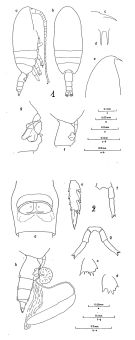 issued from : B. Frost & A. Fleminger in Bull. Scripps Inst. Oceanogr. Univ. California, San Diego, 1968, 12. [Pl.43, p.186-187; Pl.44, p.188-189]. Female: 1 a, habitus (right lateral view); 1 b, idem (dorsal view); 1 c, rostrum (right lateral); 1 d, rostrum (anteroventral); 1 e, frontal region (right lateral); 1 f, Th.4-5 (posterior part) and genital segment (right lateral); 1 g, ventral half of genital segment (right lateral); a,b,g taken from one specimen; c,e from another; d,f from third and fourth specimens, respectively; 2 a, genital segment (ventral view); 2 b, Th.4-5 (posterior part) and urosome with spermatophore attached (right lateral); 2 c, B2 of P2; 2 d, B2 of P3; 2 e, Re3 and St of P3; 2 f-g, P5; 2a-b from different specimens; 2 c-e from a third; 2 f and 2 g from fourth and fith, respectively. Nota: In lateral view ventral profile of genital segment with a prominent step posterior to genital pores
|
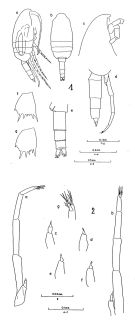 issued from : B. Frost & A. Fleminger in Bull. Scripps Inst. Oceanogr. Univ. California, San Diego, 1968, 12. [Pl.45, p.190-191; Pl.46, p.192-193]. Male: 1 a, habitus (right lateral view); 1 b, idem (dorsal view); 1 c, frontal region (right lateral); 1 d, Th.4-5 (posterior part) and urosome (right lateral); 1 e, urosome (dorsal); 1 f, B2 of P2; 1 g, B2 of P3; 1 a-d all from different specimens; 1 e-g taken from one specimen; 2 a, P5 (right lateral); 2 b, P5 (posterior); 2 c-f, right P5; 4 P5 (distal part) and 5 P5 (left posterolateral); 2 a-g taken from different specimens. Nota: Right P5 bi - or trimerous, distal segments large. A1 fused segments 20-21 more than 1.35 times as long as segment 22. Nota: Right P5 always biremous, distal segment reduced. A1 fused segments 20-21 less than 1.35 times as long as segment 22.
|
 issued from : R.B.S. Sewell in Mem. Indian Mus., 1929, X. [p.92, Fig.36]. As Clausocalanus arcuicornis forma minor. Female (from Nankauri Harbour ): a, habitus (lateral right side); b, urosome (ventral); c, genital segment; d, P2; e, P3; f, P4; g, P5; g', the end of distal segment of P5 (enlarged).
|
 issued from : B. Frost & A. Fleminger in Bull. Scripps Inst. Oceanogr. Univ. California, 1968, 12. [p.46, Table 3a]. Clausocalanus minor Females: Measurements and ratios . TL = total body length ; SL = spermatophore length ; P :U = ratio of prosome length to urosome length ; U :U1 = ratio of total urosome length to length of 1st urosomal segment (genital segment) ; S :U1 = ratio of spermatophore sac length to U1 length of female on which spermatophore is attached ; r = sample range; m = sample mean; n = number of specimens measured; s = sample standard deviation.
|
 issued from : B. Frost & A. Fleminger in Bull. Scripps Inst. Oceanogr. Univ. California, 1968, 12. [p.47, Table 3b]. Clausocalanus minor Males: Measurements and ratios . TL = total body length; P :U = ratio of prosome length to urosome length ; P:U2 = ratio of prosome length to length od 2nd urosomal segment; U2:2P5 = ratio of U2 length to length of 2nd segment of longer ramus of P5; U2:3P5 = ratio of U2 length of 3rd segment of longer ramus of P5; 3P5:2P5 = ratio of length of 3P5 of longer ramus to length of 2P5 of longer ramus; r = sample range; m = sample mean; n = number of specimens measured; s = sample standard deviation.
|
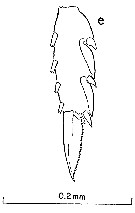 issued from : B. Frost & A. Fleminger in Bull. Scripps Inst. Oceanogr. Univ. California, 1968, 12. [p.189, Pl.44, e]. Female: e, exopodal segment 3 of P3.
|
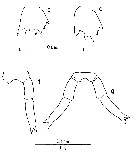 issued from : B. Frost & A. Fleminger in Bull. Scripps Inst. Oceanogr. Univ. California, 1968, 12. [p.189, Pl.44, c, d, f-g]. Female: c, basipodite 2 of P2; d, basipodite 2 of P3; f-g, P5 (from different specimens).
|
 issued from : B. Frost & A. Fleminger in Bull. Scripps Inst. Oceanogr. Univ. California, 1968, 12. [p.191, Pl.45, d, e]. Male: d, posterior part of last thoracic segment and urosome (right lateral); e, urosome (dorsal).
|
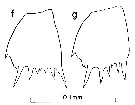 issued from : B. Frost & A. Fleminger in Bull. Scripps Inst. Oceanogr. Univ. California, 1968, 12. [p.191, Pl.45, f, g]. Male: f, basipodite 2 of P2; g, basipodite 2 of P3.
|
 issued from : B. Frost & A. Fleminger in Bull. Scripps Inst. Oceanogr. Univ. California, 1968, 12. [p.193, Pl.46]. Male: a, P5 (right lateral); b, P5 (posterior); c-f, right P5 (lateral); g, 4th segment of P5 (distal part) and 5th segment of P5 (posterolateral). from different specimens.
|
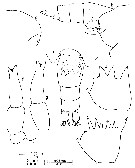 issued from : J.G. Greenwood in Proc. R. Soc. Qd, 1977, 88. [p.53, Fig.1]. Female (from 27°20'S, 153°15'E): a, forehead (lateral); b, 5th thoracic segment and urosome (lateral); c, same (ventral); d, basis of P3; e, basis of P2; f-g, P5.
|
 issued from : Y. Al-Yamani, V. Skryabin, A. Gubanova, S. khvorov & I. Prusova in Marine Zooplankton Practical Guide for the Northwestern Arabian Gulf, 2, 2011. [p.34, Fig.150]. Female (from Kuwait): A-B, habitus (dorsal and lateral, respectively); C, urosome (dorsal); D, rostrum; E, genital segment (left lateral); F, P5.
|
 issued from : Y. Al-Yamani, V. Skryabin, A. Gubanova, S. khvorov & I. Prusova in Marine Zooplankton Practical Guide for the Northwestern Arabian Gulf, 2, 2011. [p.35, Fig.152, a-c]. Female: a-b, habitus (dorsal and left lateral, respectively); c, urosome (left lateral).
|
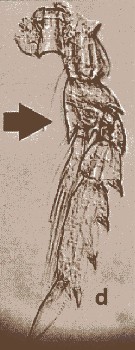 issued from : Y. Al-Yamani, V. Skryabin, A. Gubanova, S. khvorov & I. Prusova in Marine Zooplankton Practical Guide for the Northwestern Arabian Gulf, 2, 2011. [p.35, Fig.152, d]. Female: P3 (arrow indicates characteristic of the basipodite).
|
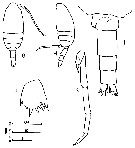 issued from : Y. Al-Yamani, V. Skryabin, A. Gubanova, S. khvorov & I. Prusova in Marine Zooplankton Practical Guide for the Northwestern Arabian Gulf, 2, 2011. [p.34, Fig.151]. Male: G-H, habitus (dorsal and left lateral, respectively); I, urosome (dorsal); J, basipodite of P3; K, P5.
|
 issued from : Y. Al-Yamani, V. Skryabin, A. Gubanova, S. khvorov & I. Prusova in Marine Zooplankton Practical Guide for the Northwestern Arabian Gulf, 2, 2011. [p.35, Fig.153] Male: a-b, habitus (dorsal and left lateral views, respectively).
| | | | | Ref. compl.: | | | Fleminger, 1967 a (tabl.1); Fleminger & Hulsemann, 1973 (p.340, carte); Carter, 1977 (1978) (p.35); Smith S.L., 1982 (p.1331, abundance, monsoon effect); Van der Spoel & Heyman, 1983 (p.44, fig.55); Madhupratap & Haridas, 1986 (p.105, tab.1); Othman & al., 1990 (p.561, 563, Table 1); Shih & Young, 1995 (p.72); Hsiao & al., 2004 (p.325, tab.1); Hsieh & al. 2004 (p.397, tab.1, p.399, tab.2); Lan & al., 2004 (p.332, tab.1, tab.2); Lo & al., 2004 (p.89, tab.1); Kazmi, 2004 (p.229); Cornils & al., 2007 (p.58, 60, 66,Rem.); Dur & al., 2007 (p.197, Table IV); Lan Y.C. & al., 2008 (p.61, Table 1, % vs stations); C.-Y. Lee & al., 2009 (p.151, Tab.2); Lan Y.-C. & al., 2009 (p.1, Table 2, % vs hydrogaphic conditions); Cornils & al., 2010 (p.2076, Table 3); Fazeli & al., 2010 (p.153, Table 1); Hsiao S.H. & al., 2011 (p.475, Appendix I); Hsiao & al., 2011 (p.317, Table 2, indicator of seasonal change); Uysal & Shmeleva, 2012 (p.909, Table I); Johan & al., 2012 (2013) (p.1, Table 1); in CalCOFI regional list (MDO, Nov. 2013; M. Ohman, comm. pers.); Tachibana & al., 2013 (p.545, Table 1, seasonal change 2006-2008); Hirai & al., 2013 (p.1, Table I, molecular marker); Ohtsuka & Nishida, 2017 (p.565, Table 22.1); | | | | NZ: | 10 + 1 douteuse | | |
|
Carte de distribution de Clausocalanus minor par zones géographiques
|
| | | | | | | | | | | | 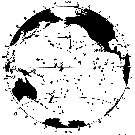 issued from : B. Frost & A. Fleminger in Bull. Scripps Inst. Oceanogr. Univ. California, San Diego, 1968, 12. [p.60, Chart 8, a]. issued from : B. Frost & A. Fleminger in Bull. Scripps Inst. Oceanogr. Univ. California, San Diego, 1968, 12. [p.60, Chart 8, a].
Occurrence of C. minor in samples examined; closed circles represent samples examined; open circles represent samples in which adults were found; bars through open circles represent samples from which specimens were removed for measurements. |
 issued from : B. Frost & A. Fleminger in Bull. Scripps Inst. Oceanogr. Univ. California, San Diego, 1968, 12. [p.61, Chart 8, b]. issued from : B. Frost & A. Fleminger in Bull. Scripps Inst. Oceanogr. Univ. California, San Diego, 1968, 12. [p.61, Chart 8, b].
Occurrence of C. minor in samples examined; closed circles represent samples examined; open circles represent samples in which adults were found; bars through open circles represent samples from which specimens were removed for measurements. |
 issued from : A. Cornils, B. Niehoff, C. Richter, T. Al-Najjar & B. Schnack-Schiel in J. Plankton Res., 2007, 29 (1). [p.60, Figs.1, 2]. issued from : A. Cornils, B. Niehoff, C. Richter, T. Al-Najjar & B. Schnack-Schiel in J. Plankton Res., 2007, 29 (1). [p.60, Figs.1, 2].
Above: Annual cycle of sea surface temperature and depth -integrated (0-100 m) chlorophyll a (mg/m2)
Below: Relative frequency (%) of the clausocalanid females over the investigation period (March 2002 to December 2003) in the northern Gulf of Aqaba (29°27'87 N, 34°57' 87 E; depth 300 m) for Clausocalanus minor, C. farrani, C. furcatus and Ctenocalanus vanus.
Nota: Collected by vertical hauls from 100 m depth to the surface. Sampling performed between 9 a.m. and 3 p.m. on a monthly basis. |
 Issued from : C.B. Miller in Biological Oceanography, Blackwell Publishing, 2005. [p.363, Fig. 16.16 (a)]. After Dessier & Donguy, 1987. Issued from : C.B. Miller in Biological Oceanography, Blackwell Publishing, 2005. [p.363, Fig. 16.16 (a)]. After Dessier & Donguy, 1987.
Time series of abundance estimates for Clausocalanus spp. (mainly C. minor, C. farrani, C. jobei) species sampled along the Pacific equator from passenger liner on a regular schedule.
Miller underlines that serial abundance for this species from the equator to 0°-2°N shows strong seasonality and dramatic reduction during the 1982-1983 El Niño (with a a sharp reduction of nitrate). A long list of other species also nearly vanished in that event. At least the stocks of hebivorous species rebounded immediately in 1984 (see E. rimana, a predator). |
| | | | Loc: | | | ? Angola (Baia Farta), South Africa, E Medit. (Lebanon Basin); Red Sea (G. of Aqaba), Gulf of Oman, Arabian Gulf, Kuwait, Somalia, Indian, Indonesia-Malaysia, Bintulu coast, SW Celebes, China Seas (East China Sea, South China Sea), Taiwan Strait, Taiwan (SW, E, W, NW, N, Mienhua Canyon), Japan (Tokyo Bay, Honshu: Suruga Bay), Hawaii, Australia ( Moreton Bay, Shark Bay, G. of Carpentaria), Tasman Sea, New Zealand, Pacif. (equatorial, tropical), California | | | | N: | 39 ? | | | | Lg.: | | | (29) F: 0,94; (30) F: 1,26-1,08; M: 1,04-0,79; ? (530) F: 1; ? (795) F: 0,96; (937) F: 1,17-1,25; M: 0,92-0,93; (1085) F: 1,1-1,3; M: 0,8-1; (1085) F: 1,1-1,3; M: 0,8-1,0; {F: 0,94-1,30; M: 0,79-1,04}
The mean female size is 1.157 mm (n = 7; SD = 0.1266), and the mean male size is 0.913 mm (n = 6; SD = 0.1019). The size ratio (male : female) is 0.77 (n = 3; SD = 0.0160). | | | | Rem.: | épipélagique.
Voir aussi les remarques en anglais | | | Dernière mise à jour : 15/09/2020 | |
|
|
 Toute utilisation de ce site pour une publication sera mentionnée avec la référence suivante : Toute utilisation de ce site pour une publication sera mentionnée avec la référence suivante :
Razouls C., Desreumaux N., Kouwenberg J. et de Bovée F., 2005-2026. - Biodiversité des Copépodes planctoniques marins (morphologie, répartition géographique et données biologiques). Sorbonne Université, CNRS. Disponible sur http://copepodes.obs-banyuls.fr [Accédé le 13 janvier 2026] © copyright 2005-2026 Sorbonne Université, CNRS
|
|
 |
 |





















